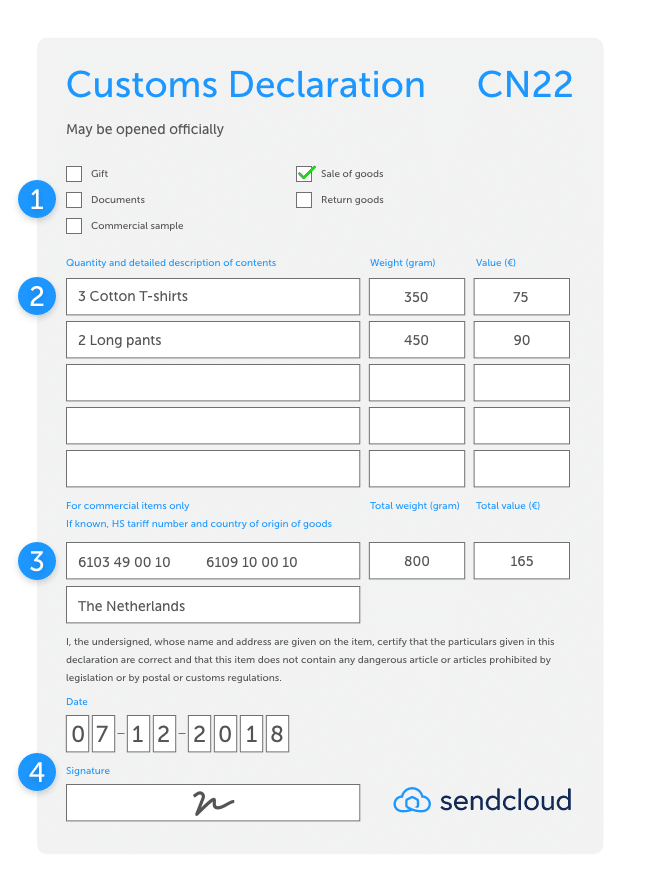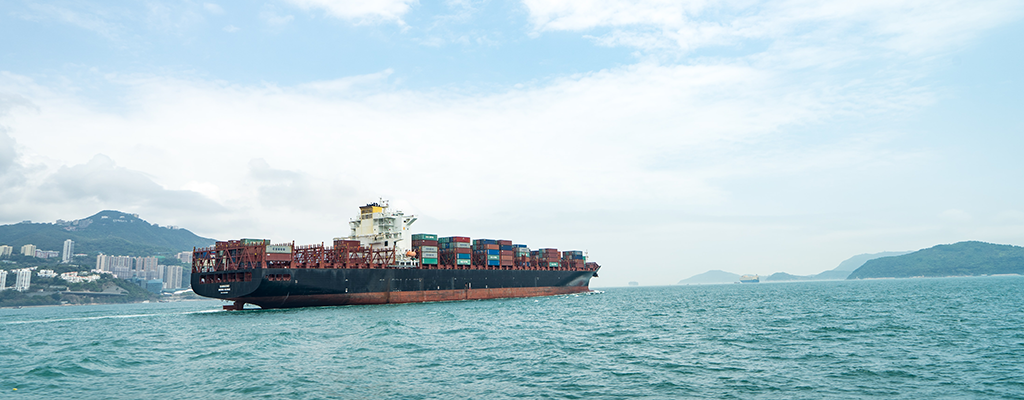Despite helping to grow an e-commerce business, international shipping can be extremely costly and cause many complex issues. And you won’t get loyal customers by passing those fees or problems onto them. Cheaper international shipping is therefore essential.
If you get it right, international shipping can help to expand your customer reach, prove your business to be a master in customer service, and ultimately increase sales and revenue. It can even help increase customer retention and loyalty. Plus – quite simply – modern online shoppers expect it.
So, how do you drive costs down while providing the outstanding service that your customers expect?
At Sendcloud, we’ve been helping e-commerce stores expand into new markets for years now, creating simple, efficient and cost-effective methods for getting their products shipped around the world.
That’s why we’ve decided to share our top tips on how to ship internationally cheap. This blog will talk you through the following steps:
- The types of international shipping available/which type of e-commerce provider they will suit.
- The main causes of expensive international shipping and why international shipping is more expensive
- Biggest mistakes to avoid in international shipping.
- Top saving hacks for international shipping
- How to choose the right international shipping provider for you
So, grab yourself a coffee and read on to discover the top tips for cheaper international shipping.
Don’t have time to read the entire blog? Download our handy checklist to effectively budget and optimize your international shipping costs!
Types of international shipping and which e-commerce provider they will suit
If you’re new to the e-commerce sector you might not be sure about which types of international shipping are available. And which methods will suit you.
To choose which method of international shipping that is right for your business, consider the following:
- Value of the goods you will be sending
- Your budget
- Size and weight of goods
- How quick you need the service to be
- Which international destinations you will need to deliver to
- The quality of service that you need
- Any additional insurance requirements.
International Couriers
International courier services ship door to door. Reputable international couriers include DPD, UPS, DHL, FedEx and GLS. This international shipping service is great for packages that need to be delivered quickly. Naturally, it’s more cost-effective for lighter loads. Most companies offer a number of services. These include different windows for delivery times. They also include different lengths of time for transit.
International Container Shipping
Unlike freight shipping, with container shipping the sender is limited by the space in their container. There are restrictions on the kinds of products you can ship this way. This includes aerosols and non-native plants.
International Air Freight
International Air Freight gets your goods to their destination quickly. Transporting them by air is the fastest method of shipping. Although you pay more for the convenience per kilo than container shipping. Prices are based on the actual gross weight or volumetric weight, whichever is greater. International air freight will usually take about 1 to 3 days between any two global destinations,
Top tip: If you want to find out where your customers are in the world – and where you might need to ship to – check out the Location report under ‘Geo’ in your Google Analytics.
Why is international shipping so expensive?
Now you have an understanding of the different types of international shipping. So what do you need to consider if you’re looking for cheaper international shipping? Here are some of the main reasons why shipping is so expensive:
- International deliveries involve a lot more work for the shipper. The parcel’s first stop is the depot. Then it’s taken to the airport and loaded on to a cargo plane. On arrival at its destination, the parcel goes through customs inspections. It is then passed to another courier to make its final journey to its destination.
- If the delivery is outside the European Union, the package may incur customs duties. Customs duties are the duties levied by a government on imported goods. Customs duties vary from country to country. They are either specific or based on the value of the goods.
- Your chosen international shipping provider is not offering competitive prices.
Which brings us neatly onto our next point…
How to avoid mistakes with international shipping
Choose a reputable supplier
This may sound obvious, but many people get this wrong. Especially when they’re starting out. Use the following tips to find the right international shipping supplier for you.
- Make a list of all your shipping requirements. Think about your future needs, too. How your company might change and grow over time.
- Consider the kind of insurance cover you and your customers will need. Your provider should be covered by a highly-reputable company. Make sure their website offers transparent information relating to their insurance. Don’t be shy to ask the company questions. Or for further information. Make sure you consider:
- Which packages need cover. Some packages are automatically covered. This is often because the items are of lower value.
- What types of items will need insuring. Insurance companies offer a variety of cover for different items. The level of cover needed will depend on the nature of the product. It may also be affected by the product value and by destination.
- If there are any caveats. As with all business decisions, make sure you read the small print. Are there items that can’t be insured? Are there any items that are limited to a certain declared value? Are there any packing rules or restrictions that apply? This could include using a certain type of box, padding, labeling or tape.
- Check out reviews of the providers online. TrustPilot, Google My Business, Facebook and Yelp are all reputable sites for customer reviews.
- Take a look at comparison sites and guides. Sendcloud has a number of guides available. If you can’t find what you need on the Sendcloud blog pages please get in touch. We’d love to help.
Fill out your paperwork properly
Incorrect paperwork can be extremely costly and won’t help you on your way to cheaper international shipping. You need to ensure your commercial invoice or other customs documents are completed correctly, including details of the item’s value, country of origin, sender’s details and the recipient’s details. If you don’t fill out the paperwork properly, you could incur a fine or your parcel may be delayed. It might even be impounded. Different rules apply to different territories. Make sure you check each country’s requirements before sending.

Know your international shipping restrictions
As mentioned above, shipping packages internationally is often subject to restrictions. This information can change at any time. Make sure the information you use is current and authoritative. These changes can include restrictions on product types, weights and other specific rules relating to each country. The rules and restrictions can also change depending on the international shipping provider. For the most up-to-date information on shipping restrictions, you can check your local government’s website for example.
Do you want to take your international shipping to the next level and turn customers into true fans? Read our blog to find out why a localized customer experience is so important and how you can deliver it!
Top saving hacks to ship internationally cheap
1: Be smart with your scheduling
Planning ahead isn’t always possible. Especially when you want to be able to respond quickly to surges in demand. If you can be smart with your scheduling, you could save money. Think about your product range. Are there any goods that you could set a longer delivery time for? One that allows time for the products to be shipped via sea freight. This method should be cheaper than air freight. Naturally, sea freight won’t be suitable for some products. There might be restrictions. Or customers may not want or expect to wait that long for the particular product.
If you opt for longer deliveries, make sure that your service will still be competitive. Check what your main competitors offer. You don’t want to be the only company that can’t deliver to meet customer expectations, after all.
2: Choose your international shipping partners carefully
The international shipping companies you partner with should be highly reputable. You and your consumers need to be 100% sure they offer the highest standards of service delivery. At all times. Remember, lower costs don’t always result in cheaper international shipping. Less reputable shipping companies may offer a low quote. But they might not be clear about any additional and unexpected costs. Check review sites and find out how each provider performs in all aspects of their service. You can also ask peers or friends to recommend suppliers. Your international shipping partner checks should include:
- Price comparison
- All additional costs
- Speed of service
- Service quality
- Insurance cover
- Customer service provision.
3: Ship with multiple international shipping companies
Using multiple carriers for different shipment services may save you money. But it can also complicate processes. Therefore it’s important to consider this option carefully. Some carriers are more competitive for larger packages. Some will offer better rates to different countries. Some will have better deals for packages that require quicker delivery.
Offering a variety of services is great for your consumers, too. They have more control over their costs. Plus the service level and speed they require.
4: Calculate your international shipping costs carefully
This sounds obvious, but making sure you’re accurate with your costs is vital for cheaper international shipping. For your own records and to make sure your offer is clear to consumers. Your cost breakdown should include the following:
- Cost of the product
- Cost of packaging
- Cost of international shipping
- All handling charges
- Duties and taxes
- Credit card fees
- Your profit margin
- Total price.
Top Tip: Need help calculating your international shipping costs? Try the free Sendcloud Price Calculator.
5: Package and address your products correctly for cheaper international shipping
The last thing you, or your consumer wants, is to receive damaged products. This harms your reputation and future sales. It can also impact negatively on customer retention. And it could result in extra costs.
International shipping guidelines state that your package should be able to withstand a drop of 1.5 metres. Here are some tips for packaging your products for international shipping.
- Fill the box with packing material such as bubble wrap or polystyrene. Do not use newspaper or other print material as international censorship rules may apply.
- Put extra tape over the corners of the shipping box to strengthen it.
- Avoid boxes that are too small for filling materials. Do not use string or twine to seal the box.
- Address the package correctly to avoid a failed delivery. Remember, countries have their own conventions when it comes to addressing packages. Check any rules and formats before sending.
- Print the name of the destination country in capital letters after the name of the town or city. Write all names English. Do not include ISO codes with the postal codes or town/city names, such as FR, D, CH, etc. This may result in errors and delays in the sorting process.
6: Cut down on packaging where possible
Reducing the amount of packaging will save you money on materials. Using boxes that are too large also increases the risk of damage to the product. And it increases your filler costs too. Don’t forget that your packaging will still need to meet safety and compliance requisites for transit.
The larger the package, the more space it takes up. This increases costs. Reducing your packaging not only helps you to achieve cheaper international shipping but also helps preserve our precious environment. This is great for your business ethics. It can also increase conversions and customer loyalty. Consumers are becoming more sustainably minded. They will often choose companies that share their ethics. Make sure you communicate your green credentials clearly on your website and marketing collateral.
Top Tip: Keep a good stock of a range of shapes and sizes of boxes and packaging. This helps reduce the risk of using packaging that is too large or the wrong dimensions to meet changes in demand.
Some international shipping companies offer free packaging. So, keep this in mind when you’re choosing your suppliers.
7: Consider Final-mile or Last-mile delivery services
Final- mile or Last-mile delivery services refers to the last leg in the parcel’s journey. The carrier drops the parcel at the recipient’s local post office and a local carrier completes the last part of the delivery. This can reduce residential surcharges and result in cheaper international shipping costs for you. But it will add a day or two onto delivery.
8: Consider using electronic trade documentation
Electronic trade documentation is an automated international shipping solution. It allows you to submit your customs documentation electronically. Using electronic trade documentation reduces paper consumption, and your printing costs. Before choosing this option, check that all relevant country’s customers will accept electronic trade documentation. Find out more about the topic in our Help Center article.
9: Consider using Ex Works (EXW) international shipping
Don’t worry if you’ve never heard of Ex Works before. Many e-commerce merchants aren’t familiar with it.
What is Ex Works (EXW)?
Ex Works, or EXW is an Incoterm (International Commercial Terms). EXW places complete responsibility on the buyer. This includes arranging and paying for shipping. It also includes managing the customs clearance. EXW is often used to give a clear cost of the product without any additional costs included. This gives transparency to the buyer. So, as long as they are happy to take responsibility for the shipping and customs, EXW can be a great for cheaper international shipping for e-commerce retailers. All the seller needs to do is provide all the necessary documents for the export processes.
As you can imagine, there are some pros and cons for the consumer. And for the merchant. Here are some of the main advantages and disadvantages for using EXW.
Advantages of EXW
- The consumer can see the product costs upfront. If the merchant offers EXW the buyer will be able to see the exact price of the product. This can make it easier to compare merchants. The buyer can be confident that the merchant is not inflating prices.
- The buyer has full control over the shipping. Some consumers will be happy to take responsibility for the costs and shipping arrangements. They can choose the level of service. And how much they want to spend on delivery and insurance. This should mean they don’t have any nasty surprises along the process. With costs or with speed of delivery.
- The consumer can take responsibility for customs clearance. The consumer may be based in a location where local knowledge of import customs is beneficial. This may give them more confidence to take control of this part of the international shipping process.
Disadvantages of EXW
- Not all consumers want the responsibility for shipping and customs. Under EXW terms, the consumer takes on all the risk for transit and customs. If they aren’t experienced with the process – or something goes wrong – they may incur additional costs. Or the delivery may be delayed.
- Using EXW can cause problems at customs. One of the main issues that arise with EXW is problems at customs in the country of origin. If the retailer does not supply the correct paperwork or an export license, the buyer may incur additional costs. The consumer may also have to pay if the goods are subject to random customs checks. Good retailers will offer clear and accurate information to the consumer to help smooth the process. And to give them confidence. This information should include the retailer’s export license. The retailer should also provide any other export documentation from the country of sale such as customs forms and advice on restrictions.
10: Consider using Free On Board (FOB) international shipping
Free On Board, or FOB, is a similar option to EXW. FOB is usually only available for sea freight. In a nutshell, FOB means the seller takes full responsibility for the package to the point that it is onboard and ready for transportation. The responsibility for successful delivery is ultimately split more equally between the merchant and the consumer.
FOB is good for buyers who are less experienced with customs, import and export. By using FOB over EXW they may have more confidence that the delivery will be successful.
Advantages of FOB
- The consumer gets full transparency on costs throughout the entire process.
- Costs can be lower for the customer than EXW. Usually the merchant can get the products to the port and cleared through customs at a lower price than a freight forwarder.
- The retailer should take responsibility for the export documents. This means both parties can be assured of a smooth service and delivery.
Disadvantages of FOB
- Consumers may get the impression that the goods cost more. This can make the retailer appear less competitive. Merchants should be clear about the costs on the website. This should include a breakdown of delivery charges and any other costs.
- Consumers take on the risks associated with the shipment after it is onboard. This may not suit every consumer.
- Unit prices may be higher with FOB. However, this does not mean the overall costs will be more.
11: Choose the right insurance
Overseas shipments are often more susceptible to damages during transit. Losses are more common too. These can have a significant impact on your profit margins. Make sure you choose robust insurance. Particularly when sending high-value items. Check that your shipping options aren’t already covered by insurance before you buy. You don’t want to pay more unnecessarily, after all! If you don’t feel the cover is good enough, consider insuring the products independently in order to achieve cheaper international shipping.
Some international shipping options are insured as standard up to a certain amount by the carrier. If you’d like to find out more about Sendcloud Insurance, please get in touch. Our insurance service covers you for any amount. It is easy to setup, totally transparent and we handle all claims quickly and efficiently. Plus it’s great value for money.
12: Invest in good international shipping technology
Using the right software and online tools can save you time and money and therefore leads to cheaper international shipping. It can also improve customer service provision and streamline processes. You can use apps to automate processes, calculate shipping and packaging, print labels, save customer preferences and much more. Using good technology also helps you manage data from multiple international shipping providers. This helps you provide more accurate quotes and to keep an eye on which suppliers are best for your business. It also helps you manage customer and supplier data more effectively. As with all business purchases, make sure you find the right tools to suit the individual needs of your e-commerce site.
Which international shipping company is best?
Deciding on which international shipping company is best for you is a big decision. You need to think about your business requirements, now and into the future. International shipping is a growth industry. Therefore there are always new players in the market. Take some time to do your research. It’s always a good idea to ask your peers and friends for recommendations too.
The best international shipping companies will offer a very flexible service. They should be able to send small parcel shipments and large freight shipments. They should offer both ocean and air options.
Here are some questions to answer before you choose your preferred international shipping company.
- How much do they charge for all types of shipping?
- Are there any additional costs?
- Do they cover all the services I need?
- Do they have any weight or size restrictions?
- Is it more cost-effective to use multiple carriers? Consider the countries you want to send to, the speed of delivery you need and any other metrics.
- Can you do most of your shipping with a single freight shipping company? If you can, you may be able to get discounts based upon volume.
- Do you need to send hazardous goods? Or goods that have other restrictions?
- Do they offer good customer service?
- What are their tracking capabilities?
- Do they offer international shipping tools that could help my business processes?
- Is this international shipping company trusted? Are the reviews good? If not, what are the main issues and are they relevant to my business?
That’s a lot of questions to answer. But don’t worry. Make a plan of your requirements then do your research. And don’t be afraid to ask questions. You’re making an important decision and you want to be sure it’s right for you, and your customers.
Which international shipping is cheapest?
Finding out which international shipping company is cheapest depends on your requirements. As above, there are a number of questions to answer. Here’s a checklist of questions to get you started.
- Which countries will you be shipping to?
- What are the sizes and weights of my goods?
- Will I need priority mail?
- How quickly will you need the goods to arrive?
- Are there any customs restrictions or processes you will need to consider?
- Will I need packaging materials?
Generally, international shipping by sea is cheaper. Though it tends to take longer. Think about all your requirements. Don’t forget that using multiple carriers can save you money (there is a section on this earlier in the article, if you missed it).
Take a look at the international shipping companies your competitors use. You can also read reviews on TrustPilot or other sites. Case studies are great too. Especially if you can find ones that are of similar companies to yours.
What are the main international shipping terms (Incoterms)?
International shipping has a number of industry-specific terms and acronyms that retailers should become familiar with. These are known as Incoterms, or International Commercial Terms. Incoterms are three-letter trade terms. They are developed by the International Chamber of Commerce. To help you get to grips with these, we have put together a complete guide to Incoterms for e-commerce retailers.
Summary on how to ship internationally cheap
- Finding the best companies and services for cheaper international shipping can be complicated. It is a crowded market place. And there are always new entrants to the sector.
- Finding the cheapest international shipping service takes time. It isn’t a decision that you should make lightly. Using a regular shipping supplier helps you plan for the future. It helps you calculate costs. It builds good supplier relationships. And it gives your customers confidence in your international shipping services.
- Take some time to get a clear idea on your business requirements. And your plans, both short-term and long-term. Consider the needs of your business and of your customers and how will they be effected by your strategy for cheaper international shipping. Read plenty of reviews from reputable websites and talk to your industry peers. With a bit of patience and good research skills you will find the right international shipping company for your business.
For insights on forecasting and optimizing your international shipping costs, check out our free checklist!
Want to learn more about international shipping?
At Sendcloud, we specialize in helping e-commerce businesses optimize their shipping processes and save on costs. Learn more about international shipping with Sendcloud!




















